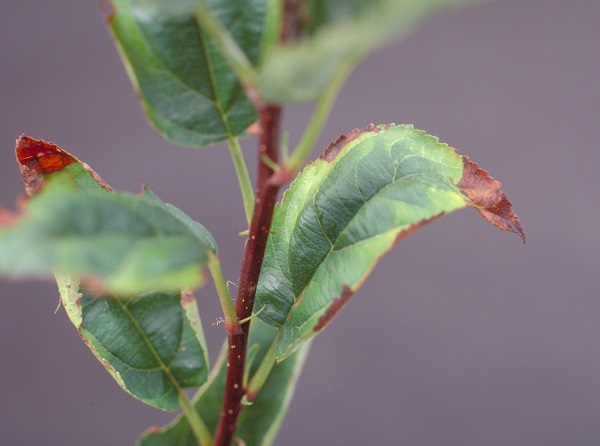Leafhoppers on Apples
ENTFACT-215: Leafhoppers on Apples | Download PDF
by Ric Bessin, Extension Specialist
University of Kentucky College of Agriculture
Leafhoppers can be serious pests of apple plantings. In established orchards, the white apple leafhopper, rose leafhopper, and potato leafhopper can be common pests, while on new plantings it is the potato leafhopper that is most serious.
Whitish spots or stippling on upper leaf surfaces are evidence of white apple leafhopper and rose leafhopper feeding. Sticky honeydew secretions from leafhopper feeding frequently cover lower fruits and are called "tar spotting." Leafhoppers feed with piercing-sucking mouthparts. Damage is caused by nymphs and adults removing chlorophyll and sap from the lower leaf surface which can affect fruit development and bud formation. Adults may be a nuisance if they are abundant at harvest as they can be inhaled by pickers. The potential for rose leafhopper is largely dependent on the density and proximity of orchards to the primary overwintering host, florabunda rose.

Figure 1. Potato leafhopper damage to apple.
Damage by potato leafhopper is less common and is characterized by yellowing and necrotic leaf margins. While these damaged areas are typically “V” shaped, intense feeding can cause the entire leaf margin to be affected.
The bronzed, dried appearance of leaf tips is referred to as "hopper burn.” Leaf margins on injured leaves often curl downward. While white apple leafhopper is found on cluster leaves and not on actively growing terminal shoots, potato leafhopper is more of a threat to young, non-bearing fruit trees with young, tender foliage.
Description
White apple leafhopper and rose leafhopper adults are very similar in appearance. The adults are long and slender, wedge-shaped, with a convex back. The body is a light yellow with the head slightly darker.
Juveniles are generally pale white, wingless, and "scurry" around when disturbed. While white apple leafhopper nymphs are without noticeable markings, older rose leafhopper nymphs have a few small black spots on the black of the thorax and wingpads.
Potato leafhopper is light green. Potato leafhopper can be distinguished from white apple leafhopper by the tendency of white apple leafhopper to walk forward and backward while potato leafhopper walks sideways as well as forward and backward.
Biology
White apple leafhopper overwintering eggs begin hatching at pink, and hatching is usually complete by petal fall. The nymphs move to the undersides of the leaves to feed. First generation adults begin to appear in June. There are two generations of white apple leafhopper per year. The second-generation adults are often noticeable during harvest.

Figure 2. White apple leafhopper and cast skins on underside of leaf.
Rose leafhopper overwinters as eggs on wild roses and brambles. Nymphs emerge in the spring and feed on the wild hosts. In June, newly emerged adults disperse and move to apples. The second and third generations feed on apples. In the fall, adults return to their wild hosts to lay eggs.
Potato leafhopper develops throughout the year in the southern United States near the Gulf of Mexico, and migrates northward each growing season rather than overwintering in northern states. The appearance of potato leafhopper is therefore less predictable because its migration is dependent upon the jet stream and other weather patterns.
Management
Monitor from bloom through petal fall for nymphs of the white apple leafhopper. Examine a leaf from the middle of a fruit cluster on 25 clusters from each of five trees. If an average of 3 or more nymphs per leaf is detected, then use an insecticide specifically targeted for leafhopper in addition to your cover spray insecticide at petal fall. With the second generation of white apple leafhopper and for rose leafhopper, examine 25 leaves per tree and treat with an insecticide if there is an average of 3 or more nymphs per leaf.
Growers should monitor young apple plantings for potato leafhopper and initial signs of damage. Consider treatment of young blocks when potato leafhoppers first appear, particularly where they have been a problem with them in the past.
The white apple leafhopper has become resistant to commonly used cover spray insecticides, such as Guthion (tm) and Imidan (tm). Provado (tm) is very effective against this insect and it is less disruptive on mite management. In orchards where leafhoppers have become troublesome, it is important to include an effective leafhopper control in the first cover spray. Young leafhoppers are easier to control than adults. The first brood is an easier target than the second brood because the hatch is more synchronous.
Revised: 11/19
CAUTION! Pesticide recommendations in this publication are registered for use in Kentucky, USA ONLY! The use of some products may not be legal in your state or country. Please check with your local county agent or regulatory official before using any pesticide mentioned in this publication.
Of course, ALWAYS READ AND FOLLOW LABEL DIRECTIONS FOR SAFE USE OF ANY PESTICIDE!
Photos courtesy Ric Bessin, University of Kentucky Entomology
